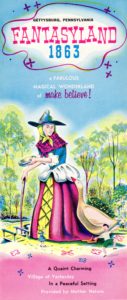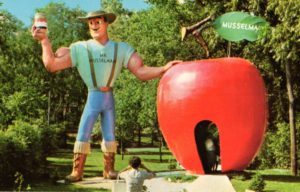 It was a place where families made happy memories, and now it only exists as happy family memories. Fantasyland in Gettysburg, Pa., entertained tens of thousands of youngsters and the young at heart from 1959 to 1980.
It was a place where families made happy memories, and now it only exists as happy family memories. Fantasyland in Gettysburg, Pa., entertained tens of thousands of youngsters and the young at heart from 1959 to 1980.
Kenneth and Thelma Dick took their family to the shore for a vacation in 1957. On their way home, they stopped at Storybook Land near Atlantic City, N.J. It was a small park, planned to entertain young children like the three Dick girls.
“My mother kept saying the whole time, ‘I could do better than this. This is so okay, but I could do something so cute,’” Jacqueline White said. She is the middle child of the three Dick girls between her sisters, Stephanie and Cynthia.
White’s parents spent the four hours of the drive home, planning the park and how they would market it. Because they wanted to locate it where there were a lot of people, the Dicks had to decide on whether they would build their park in Lancaster or Gettysburg.
Gettysburg won, in part because Kenneth Dick was from this area and was a graduate of Biglerville High School. However, the Dicks also had a strategic reason for locating the Fantasyland in Gettysburg.
“Parents bring their children to Gettysburg, and they will climb on the cannons and run across the field, but after an hour, they’ll be saying, ‘Dad, what else is there to do?’ Fantasyland gave little kids something to do,” White said.
Fantasyland 1863 opened in July 1959. “This is Fantasyland…,” the brochure promised. “a world set apart… a world where stories… and dreams… of elves and fairies… and all the storybook characters come to life… in a beautiful setting with the ‘gentle look’ of long ago.”
To enter the park, you had to walk through a short door that part of a large storybook. The door was only five feet tall. If a person walked in without stooping, he or she was charged the children’s price of 60 cents. People who stooped were charged an adult admission of a dollar.
“We had a lot of grandmothers get in for the children’s price,” White said. “They loved it.”
The first thing a person saw walking into the park was a 23-foot-tall Mother Goose statue with her goose. A girl in the storybook office could see visitors approaching the statue and speak to them through a microphone, which delighted the younger children. A few keen observers will note that Mother Goose changed her appearance during the park’s life. A fire burned the original statue’s head off and a new one was built to replace it.
Children could also talk to several different live costumed characters, such as Raggedy Ann and Andy, Little Bo Beep, the Easter Bunny, or a Fairy Princess.
The park was originally 23 acres but grew over time to 35 acres as new attractions were added. While most of the attractions had a storybook character theme like the Old Woman Who Lived in a Shoe or Rapunzel’s Castle, you could also visit Santa’s Village, watch a Wild West Show, take in an animal show where rabbits and chickens had been trained to play baseball, basketball, and the piano. The park featured 11 rides, four live shows, and several displays.
“The Winter Wonderland started out as a scary inside ride, but we bought it and my mother transformed it into the Winter Wonderland,” White said.
 Thelma had a gift for things like that. She created beautiful gardens throughout the park and designed many of the attractions. On a Christmas trip to New York City, she enjoyed the window displays in Macy’s so much that she walked into the store and bought all the displays. She then had buildings constructed with each one holding a moving Christmas display. This became Santa’s Village. Musselman’s even paid for an apple-oriented attraction to be constructed at the park.
Thelma had a gift for things like that. She created beautiful gardens throughout the park and designed many of the attractions. On a Christmas trip to New York City, she enjoyed the window displays in Macy’s so much that she walked into the store and bought all the displays. She then had buildings constructed with each one holding a moving Christmas display. This became Santa’s Village. Musselman’s even paid for an apple-oriented attraction to be constructed at the park.
“I liked it best at night,” White said. “We stayed open until 10 p.m. and we had the trees full of colored lights that we turned on. It was beautiful.”
This was all amid a wooded setting with trails that wound through landscaped gardens. You could also see plenty of live animals, such as tame fawns, trained rabbits, calves, and raccoons.
You might also enjoy these posts:
- Monkey hunting in Gettysburg
- Drag racing through Gettysburg before there were cars
- Find out how the Marines would have fought the Battle of Gettysburg
One Reply to “Where Fairytales Came to Life on a Civil War Battlefield (Part 1)”
Comments are closed.